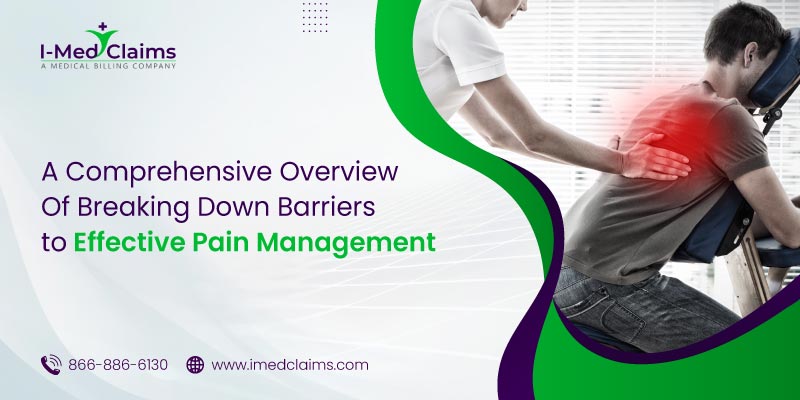Pain is a universal human experience, affecting millions across the globe. Pain management is a complex process that requires attention to the patient’s overall health and well-being, including physical, emotional, and social factors. Pain management requires specialized skills to assess and manage the symptoms effectively. However, achieving effective pain management is often hindered by various barriers impeding optimal care and outcomes. This detailed blog will explore the most common barriers to effective pain management and discuss potential solutions to overcome these challenges.
A Holistic Approach To Pain Management
Pain management involves a holistic approach to alleviating pain, enhancing the patient’s ability to engage in daily activities, and improving their overall quality of life. This encompasses various interventions, including medications, physical therapy, interventional procedures, and psychological support.
Lack of Understanding of Pain Management
One of the most significant barriers to effective pain management is the lack of understanding among healthcare professionals about pain and its management. Pain is a complex phenomenon that requires a multifaceted approach. It’s not just a physical sensation but also has psychological and social dimensions. Some healthcare providers ignore the needs of patients and prescribe medication as a standard approach to managing pain.
Myths and Misconceptions About Pain
Misconceptions about pain are common among patients and healthcare providers. Some of these myths include the belief that pain is a sign of weakness, that pain is only physical, and that using medication for pain leads to addiction. These myths and misconceptions can prevent individuals from seeking appropriate pain management and prescribing effective plans.
Solution: Improving education and awareness about pain, its diverse manifestations, and its impact on individuals can help dispel myths and reduce stigma. Training healthcare professionals to actively listen to patients and validate their pain experiences can improve pain assessment and management.
Inadequate Pain Management Training
Inadequate training in pain management can also create barriers to effective pain management. Healthcare professionals lacking proper pain management training may not be equipped to diagnose and treat complex pain syndromes effectively. This lack of training can lead to inadequate pain management, which creates barriers and frustration for patients seeking relief from their symptoms.
Solution: Implementing standardized pain assessment protocols, training healthcare professionals on utilizing these tools, and encouraging comprehensive pain assessments can help overcome this barrier.
Fear of Opioid Addiction and Misuse
The opioid epidemic has instilled a fear of addiction and misuse associated with opioid pain medications. Healthcare providers may hesitate to prescribe opioids, even when they are medically appropriate, leading to inadequate pain relief for patients with severe pain.
Solution: Enhancing education and training on safe opioid prescribing practices, promoting responsible opioid use, and encouraging alternative pain management strategies can address this barrier. Additionally, utilizing prescription monitoring programs can help track and mitigate misuse.
Inadequate Access to Specialized Pain Management Services
Many patients do not have access to specialized pain management services due to geographical location, financial constraints, or a shortage of pain specialists. This lack of access limits the availability of comprehensive and multidisciplinary pain management approaches.
Solution: Enhancing healthcare infrastructure to ensure equitable access to pain management services, leveraging telemedicine for remote consultations, and integrating pain management into primary care can improve accessibility to specialized care.
Patient-Provider Communication Challenges
Effective communication between patients and healthcare providers is crucial for successful pain management. Patients may struggle to articulate their pain experiences, and healthcare providers may struggle to effectively understand and address patient concerns.
Solution: Promoting patient education on effective pain communication, fostering open and honest dialogues between patients and healthcare providers, and encouraging active participation of patients in their pain management plans can help bridge communication gaps.
Socioeconomic Factors and Health Disparities
Socioeconomic factors, including income, education, and insurance coverage, can significantly impact a patient’s access to appropriate pain management. Disparities in healthcare access and resources can result in unequal pain management experiences.
Solution: Addressing socioeconomic disparities through policy reforms, expanding health insurance coverage, implementing community outreach programs, and supporting socioeconomic interventions can help alleviate this barrier to effective pain management.
Pain Management Billing: Navigating Financial Barriers
Apart from the challenges faced in delivering effective pain management, navigating the intricate world of pain management billing poses its obstacles. Accurate and efficient billing is crucial to sustain healthcare practices and ensure patients receive the necessary treatments without financial burdens.
Coding Accuracy and Compliance
Accurate coding of procedures and services related to pain management is crucial for billing. Understanding and adhering to coding guidelines and regulations set by insurance companies and governmental bodies is essential. Continuous education and training for healthcare providers and billing professionals in pain management billing practices, coding updates, and compliance regulations can significantly enhance accuracy and efficiency.
Timely Billing and Reimbursement
Timely submission of bills and claims is imperative to ensure a steady flow of revenue for healthcare providers. Delays in billing can disrupt cash flow and impact the ability to provide consistent pain management services. Implementing advanced billing software and electronic health record systems can streamline the billing process, reduce errors, and improve billing efficiency.
Denial Management
Addressing denied claims can prove to be a time-consuming and arduous task. An efficient denial management system is vital to appeal denied claims promptly and maximize reimbursements. Open communication and collaboration between healthcare providers and billing teams can enhance understanding and compliance with billing procedures, ultimately improving the revenue cycle.
Conclusion
Pain management is a crucial aspect of healthcare that can help patients avoid unnecessary suffering and restore their quality of life. Understanding the barriers to effective pain management is essential for patients and healthcare providers to create comprehensive, effective pain management plans. Addressing these barriers would improve the quality of life for millions with chronic pain.


